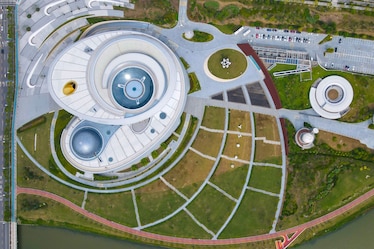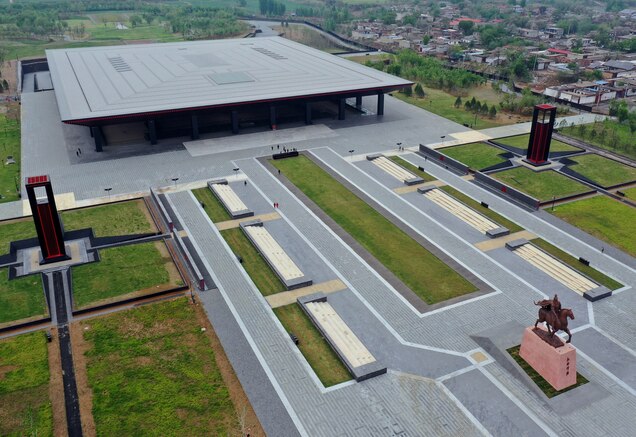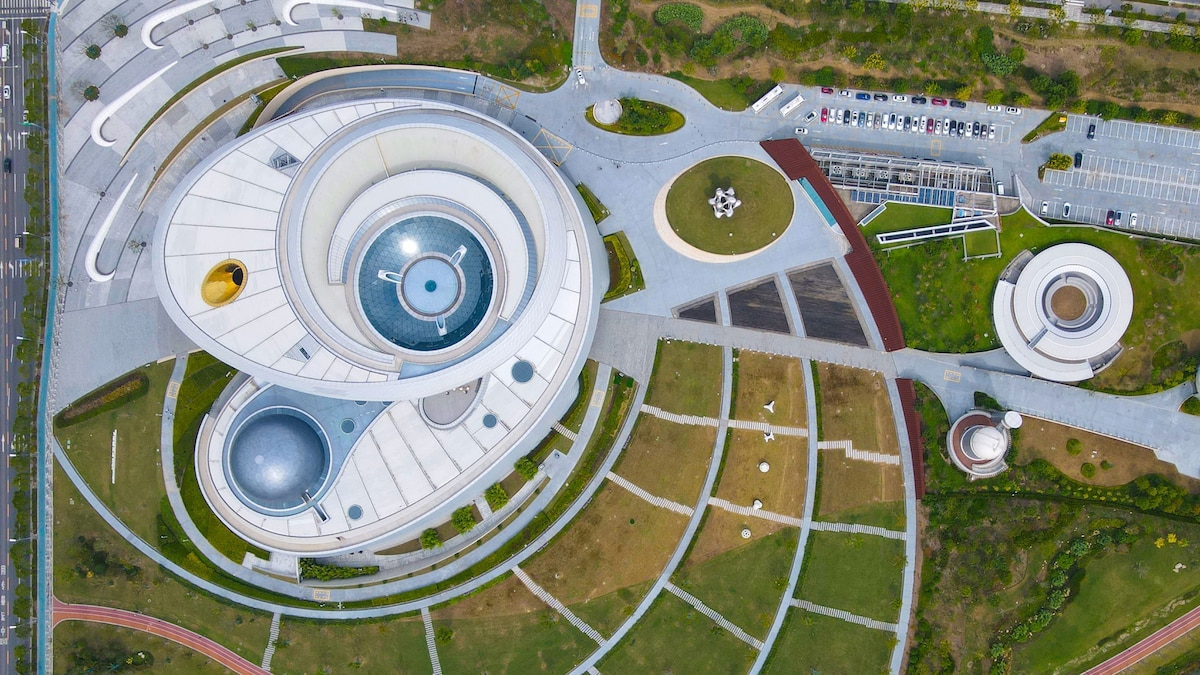beijingwalker
ELITE MEMBER

- Joined
- Nov 4, 2011
- Messages
- 65,191
- Reaction score
- -55
- Country
- Location
China just had a museum building spree. Here are 6 of the best
While its borders were locked during the pandemic, the country began constructing buildings dedicated to art, sound, science fiction, and more.BYRONAN O’CONNELL
PUBLISHED OCTOBER 11, 2023

This aerial photo shows the Shanghai Astronomy Museum, one of a spate of museums featuring stunning designs that have opened in China in recent years.
China is amid an extraordinary museum boom, constructing more than 20 new cultural facilities since 2020. Set in cities, towns, and even mountain villages, they variously showcase archaeology, astronomy, science fiction, and imperial history.
Travelers returning to China, which is now reissuing tourist visas, will also find these museums showing off cutting-edge architecture. Some resemble giant log cabins, others mimic geological formations or are cloaked in thousands of glass “fish scales.” Collectively, they represent China’s vast resources and grand ambition, academics say.
“Museums are a must-have indicator of national rejuvenation, modernization, and civilization,” says Yingjie Guo, professor of Chinese Studies at the University of Sydney. “Even county towns have at least one.”
China’s size helps explain how it can execute so many major projects, says David Goodman, director of the Chinese Studies Centre at the University of Sydney. This nation covers a similar amount of land as the United States, but has more than four times the population, at 1.4 billion people.
“Admittedly most countries do not build one new major museum a year,” he says. “[But] the People’s Republic [of China] currently has 32 provincial-level jurisdictions, each of which is comparable to a country elsewhere in the world in terms of population, land area, languages, and cultural diversity.”
Meanwhile, their eye-catching architecture makes many Chinese museums “trophy buildings,” says Thomas Campanella, professor of city planning at Cornell University. “One of the hallmarks of contemporary Chinese urbanism is an emphasis on dazzling works of civic or institutional architecture, often by world-famous architects,” he explains. “[They’re] meant to signal arrival and status on the part of a municipality, not unlike a parvenu swanning about with a Prada bag or Rolex watch.”
Here are six of China’s most significant new museums.
Shanghai Astronomy Museum
From above it appears as if a massive metallic oyster has been shucked to expose a shimmering pearl. This avant-garde building offering the cosmos such a striking view houses the Shanghai Astronomy Museum. Launched in 2021, it is reputedly the world’s largest planetarium building, covering more than 630,000 square feet.
A visitor wearing a VR headset experiences walking on the moon at the Shanghai Astronomy Museum on opening day, July 17, 2021, in Shanghai, China.
PHOTOGRAPH BY YANG JIANZHENG, VCG/GETTY IMAGES
In its three main galleries—Home, Universe, and Journey—visitors can see 70 meteorites, 150 interactive exhibits, and more than a hundred artifacts linked to revered astronomers like Galileo. They can also watch high-definition footage of galaxies in a huge dome theater with an 8K screen.
Guangzhou Museum of Art
Covered in 21,008 pieces of “fish scale” glass, designed to mimic a blooming hero flower, and boasting a five-story atrium, the Guangzhou Art Museum is unapologetically ostentatious. When it opens this year reportedly near Canton Tower, it will become a landmark of China’s fifth largest city (population 18 million). Seven floors of exhibits display Chinese paintings, watercolors, calligraphy, sculpture, illustrations, comic books, lacquerware, and photography from ancient to contemporary times.Beijing Sound Art Museum
For a decade, local artist Colin Chinnery regularly walked the streets of China’s capital, capturing noises that are gradually disappearing from this modernizing metropolis. Now the Beijing Sound Art Museum catalogs hundreds of his audio recordings of Beijing’s evolving soundscape—from the booming calls of traditional street vendors to piercing pigeon whistles blown in parks. Opened this May, it’s located in Songzhuang Art District of Tongzhou, in Beijing’s eastern suburbs.(Learn how to travel the world—by radio.)
Chengdu Science Fiction Museum
This month, the world’s biggest science fiction convention, Worldcon, is scheduled to be the first major event at this Zaha Hadid–designed museum. True to its subject, the soon-to-open facility could pass for a futuristic space station. Its roof was designed to emulate an “expanding nebula cloud with a star at its center,” the architects explain.Located on Jingrong Lake within the Pidu District’s Science & Innovation New City, the roughly 635,000-square-foot museum explains Chengdu’s status as the national hub of science fiction writing. It was in this mountain-flanked city that China’s most popular science fiction magazine, Science Fiction World, was first published in 1979.
The museum’s theater and hall will hold dozens of talks, including lectures on how Chinese mythology shapes its science fiction tales. The thousands of visitors to Worldcon—held annually since 1946 but making its China debut—can also attend autograph sessions with Chinese science fiction legends, such as Dong Renwai.
(Explore otherworldly realms in these 13 fantastical tales.)
Sui-Tang Dynasties Grand Canal Culture Museum
Topped by a yellow roof that resembles a line of sliced bamboo branches, this museum located on the Luo and Xian Rivers in Luoyang, Henan Province, celebrates one of the world’s greatest engineering feats. Some 2,500 years ago, China built an enormous network of waterways stretching 1,100 miles from Beijing south to Hangzhou. Called the Grand Canal, it linked key Chinese communities.On display in the museum are shipwrecks recovered from the canal, as well as murals of ancient Luoyang that depict its bustling canal activities. Interactive exhibits teach visitors about the history and design of these waterways, which are a UNESCO World Heritage site.
Cao Cao Mausoleum Museum

The Cao Cao Mausoleum Museum, located in Anyang City, China, was built around the tomb of one of the country’s fiercest warlords. The museum displays over 400 cultural relics unearthed from the burial site, including stone plaques and tablets and pottery tripods...Read More
PHOTOGRAPH BY LI AN, XINHUA/GETTY IMAGES
He was a warlord poet, posthumously named an emperor, who led an army of a million men during an era of bloody chaos in China. Now the 1,800-year-old story of General Cao Cao is being told to tourists at a museum built around his tomb, which was recently excavated here near Anyang City. Anchored by a towering statue of Cao Cao on horseback, this complex in Xigaoxue village exhibits about 400 artifacts—stone tablets, plaques, and ceramics—all unearthed from his mausoleum.

China just had a museum building spree. Here are 6 of the best.
While its borders were locked during the pandemic, the country began constructing buildings dedicated to art, sound, science fiction, and more.
